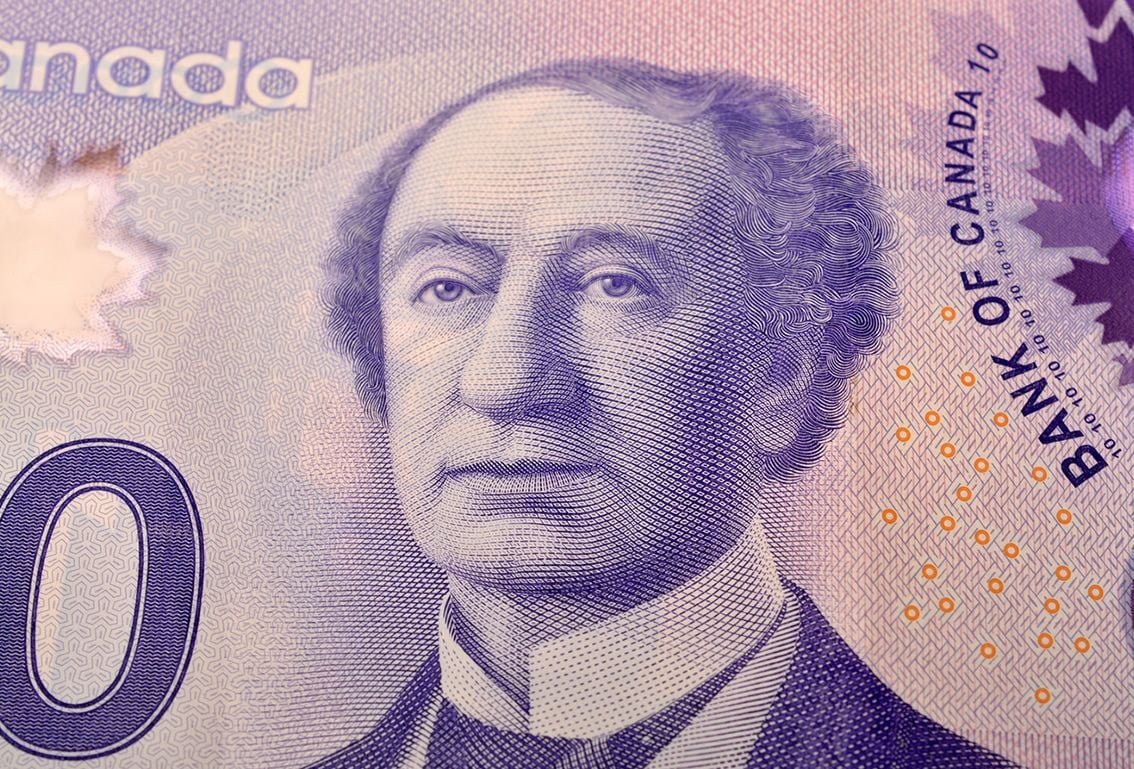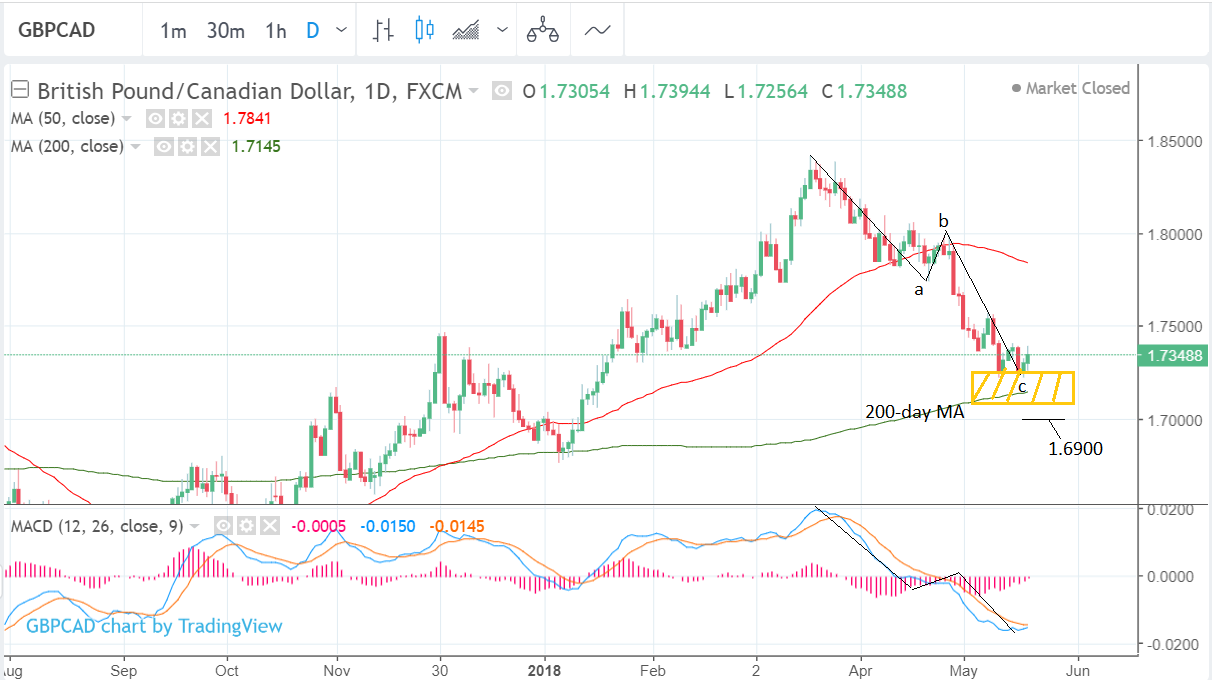The Pound-to-Canadian Dollar Rate's Forecast For The Week Ahead
- GBP/CAD short-term downtrend vulnerable to reversal and rebound higher
- The main releases for the Pound are inflation and retail sales data
- The Canadian Dollar's main release is wholesale sales which is forecast to enter positive territory

© Stockyme, Adobe Stock
One Pound buys 1.7348 Canadian Dollars at the time of writing on the interbank market.
The pair has more or less moved sideways over the preceding week as poor retail sales data has weighed on the Canadian Dollar and marginally easing Brexit risks supported Sterling, as it now appears a form of customs union will extend into 2021.
From a technical perspective, the pair remains in a short-term downtrend after rolling over following the March highs at 1.8416, however, that short-term trend now looks vulnerable to reversing and rebounding.
The move down from the March highs appears to have formed the outline of what may be a potential abc (or abcd) corrective pattern, which now potentially looks complete, as legs a and c appear to be of a similar length, and this is an indication the correction may be over and the uptrend could be about to resume.
The pair is also closing in on the level of the 200-day moving average (MA) at 1.7145 which will probably resist further downside and present a formidable obstacle to bears.
Major moving averages are the location of heightened supply and demand dynamics which often lead to the dominant trend stalling or even reversing.
The MACD indicator in the lower pane looks like it may also be basing in a reflection of the exchange rate and also suggests the possibility of a recovery higher.
Given all the above signs of exhaustion, we are a little wary of calling an extension of the short-term downtrend, but at the same time, given there are no particularly bullish signs of a reversal yet either, we have decided to desist from making a forecast this week as the evidence is too finely balanced to suggest a bias one way or another.
Canadian Dollar: What to Watch
The Canadian Dollar lost ground last week after monthly retail sales data showed a surprise -0.2% contraction in March and raised concerns the Canadian consumer might be easing back on spending.
This offset slightly the optimistic talk from the governor of the Bank of Canada (BOC) which suggested the Bank was prepared to raise interest rates twice in 2018 after inflation rose above the target 2.0% mark.
Higher interest rates would be supportive of the Canadian Dollar because they usually attract greater inflows of foreign capital, drawn by the promise of higher returns.
One overhanging risk for CAD, however, is how the NAFTA negotiations unfold, although an offsetting positive could come from rising oil prices, as crude is Canada's principal export.
In the week ahead, data is pretty thin on the ground, with the main releases consisting in largely lesser tier data which is unlikely to move CAD.
The week starts with wholesale sales on Tuesday, May 22 at 13.30 GMT which is forecast to show a 0.6% rise in March from -0.8% in February.
The budget balance is scheduled for release on Friday, May 25 at 16.00 - previously it showed a 2.83bn surplus.
GBP: What to Watch
It's a busy week ahead for Sterling traders, with a welter of economic releases due for the Pound.
Inflation data, out at 9.30 on Wednesday, forms the main data event with traders looking to see whether prices are moving in a direction consistent with further interest rate rises at the Bank of England. Over recent months we have seen the Pound become increasingly attuned to Bank of England interest rate expectations; moving higher when expectations for a rate rise increase, and moving lower when those expectations are rowed back.
We recently reported that economists at Capital Economics are expecting two interest rate rises in 2018 which would present an highly bullish outcome for Sterling, but the data will have to start moving in the right direction very soon for this assumption to prove correct.
And of course, the Bank of England is watching the data and will only move on rates once they have evidence the economy is picking up pace once more.
"UK inflation figures from April will be closely watched by markets and influence the pricing of Bank of England," says Andreas Steno Larsen, a strategist at Nordea Bank.
Inflation is expected to fall to 2.1% from 2.3% as base effects from the weak Pound start to fall away.
"As for April there is a clear risk of a rather low result due to base effects," adds Larsen.
Analysts at Investec are more bullish about inflation in April:
"We expect to see inflation tick up to 2.6% from 2.5%, albeit with the April rise likely to be a blip on a path in which we see inflation moderating," says Investec economist Victoria Clarke.
Global oil prices have been on the rise, and we would expect this to perhaps deliver an upside surprise. However, the core CPI release will therefore be crucial as it strips out the likes of external one-offs like oil, and the Bank of England uses the number as a proxy for underlying wage growth. In short, a beat on the core CPI would likely help Sterling higher, core is forecast to read at 0.5%.
In other UK releases, retail sales figures due Thursday morning will also be closely watched amidst concerns about UK growth (and consumer spending) momentum.
The BRC’s April figures were particularly weak, with the timing of Easter a depressing factor; we suspect the ONS’s Easter timing adjusted numbers will not look quite so gloomy.
The second estimate for UK GDP growth is due at the end of the week where Clarke suspects we will see an unrevised reading of +0.1% print. A beat would however likely boost Sterling.
Right at the beginning of the week we get some second-tier numbers with public sector finances released at 9.30, they are expected to show government borrowing fall by 7.0bn in April. Recent public sector data has been positive on the whole so a further fall in borrowing would be seen as a positive for the economy, although a surprise reading either way would pobably be necessary to move the Pound.
The Consortium of British Industry will also be releasing two reports for the month of May: the CBI Industrial Trends survey at 11.00 GMT on Monday and the Distributive Trades survey at the same time on Wednesday. Both will provide the most up-to-date information on economic activity in the UK and could, because of their timeliness, impact on Sterling.
Get up to 5% more foreign exchange by using a specialist provider to get closer to the real market rate and avoid the gaping spreads charged by your bank when providing currency. Learn more here.






